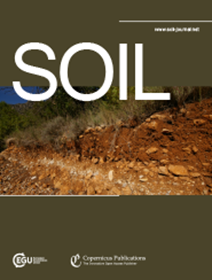通过计算土壤中的细胞外 DNA 改进微生物生长、死亡和更替的测量方法
IF 5.8
2区 农林科学
Q1 SOIL SCIENCE
引用次数: 0
摘要
摘要微生物的呼吸、生长和周转是土壤有机质形成和分解的驱动过程。与呼吸和生长相比,微生物的更替和死亡目前缺乏独特的测定方法。在此,我们提出了一种新方法来确定微生物的死亡率,并改进微生物生长的测量。通过将区分细胞内和细胞外 DNA 的连续 DNA 提取与 DNA 中的 18O 结合起来,我们能够测量微生物的死亡率。我们首先评估了分别确定和提取细胞内和细胞外 DNA 的方法。我们的结果表明,虽然特定质量的呼吸作用和总生长量会随温度升高而增加或保持稳定,但微生物死亡率在 45 ° C 时会大幅增加,并导致微生物生物量下降,进而导致微生物净生长量下降。我们进一步发现,与较低温度相比,45 °C时细胞外DNA池也有所减少,这进一步表明,随着呼吸、生长和死亡率的增加,细胞外DNA的吸收和循环也得到了加强。为了更好地了解微生物死亡在土壤碳循环中的作用,我们有必要在更多不同生态系统的土壤中进行更多实验,并测试温度以外的其他因素对微生物死亡的影响。不过我们相信,这种分别测定微生物死亡率以及细胞内和细胞外 DNA 动态的新方法将有助于改进未来土壤中 C 动态的概念和模型。本文章由计算机程序翻译,如有差异,请以英文原文为准。
Improving measurements of microbial growth, death, and turnover by accounting for extracellular DNA in soils
Abstract. Microbial respiration, growth, and turnover are driving processes in the formation and decomposition of soil organic matter. In contrast to respiration and growth, microbial turnover and death currently lack distinct methods to be determined. Here we propose a new approach to determine microbial death rates and to improve measurements of microbial growth. By combining sequential DNA extraction to distinguish between intracellular and extracellular DNA and 18O incorporation into DNA, we were able to measure microbial death rates. We first evaluated methods to determine and extract intracellular and extracellular DNA separately. We then tested the method by subjecting soil from a temperate agricultural field and a deciduous beech forest to either 20, 30, or 45 °C for 24 h. Our results show that while mass-specific respiration and gross growth either increased with temperature or remained stable, microbial death rates strongly increased at 45 °C and caused a decrease in microbial biomass and thus in microbial net growth. We further found that also extracellular DNA pools decreased at 45 °C compared to lower temperatures, further indicating the enhanced uptake and recycling of extracellular DNA along with increased respiration, growth, and death rates. Additional experiments including soils from more and different ecosystems as well as testing the effects of factors other than temperature on microbial death are certainly necessary to better understand the role of microbial death in soil C cycling. We are nevertheless confident that this new approach to determine microbial death rates and dynamics of intracellular and extracellular DNA separately will help to improve concepts and models of C dynamics in soils in the future.
求助全文
通过发布文献求助,成功后即可免费获取论文全文。
去求助
来源期刊

Soil
Agricultural and Biological Sciences-Soil Science
CiteScore
10.80
自引率
2.90%
发文量
44
审稿时长
30 weeks
期刊介绍:
SOIL is an international scientific journal dedicated to the publication and discussion of high-quality research in the field of soil system sciences.
SOIL is at the interface between the atmosphere, lithosphere, hydrosphere, and biosphere. SOIL publishes scientific research that contributes to understanding the soil system and its interaction with humans and the entire Earth system. The scope of the journal includes all topics that fall within the study of soil science as a discipline, with an emphasis on studies that integrate soil science with other sciences (hydrology, agronomy, socio-economics, health sciences, atmospheric sciences, etc.).
 求助内容:
求助内容: 应助结果提醒方式:
应助结果提醒方式:


